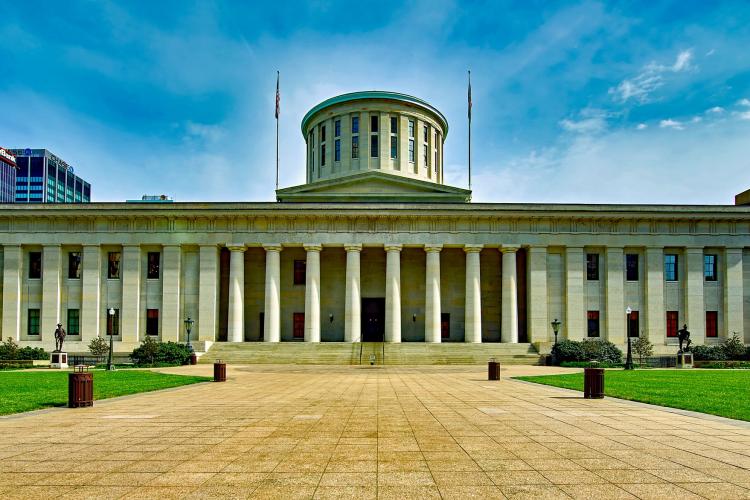
With the conclusion of the 132nd General Assembly Session on December 31, 2018, a bill to significantly curtail Ohio’s energy efficiency resource standard (EERS) officially died, leaving the state’s clean energy economy preserved. This was a victory for Ohio’s many clean energy jobs, its economy, customers’ energy bills and the environment.
But the path to victory was not easy, and a diverse set of stakeholders, including MEEA, spent two years working with policymakers to ensure they understood the benefits of energy efficiency and the potential costs of passing H.B. 114.
A Brief History
The debate over Ohio’s EERS has been an ongoing fight in Columbus for the last five years. While the state has historically been a leader on energy efficiency—for example, in 2008 Ohio created a cumulative 22% energy savings requirement by 2025—there have been several barriers to this progress. In 2013, S.B. 58, as proposed, would have significantly weakened energy efficiency programs and first introduced the idea of an industrial opt-out. As a compromise to S.B. 58, the legislature and governor agreed to the passage of S.B. 310 in 2014 that temporarily froze the EERS for two years (2015 and 2016) and officially created an industrial opt-out for any electric energy customers using 4.5 gigawatt hours or more annually. Even though the freeze ended December 2016, the provisions in S.B. 310 currently govern the state’s energy efficiency policies. Notwithstanding the compromise law in place, the legislature has made two additional attempts to curtail the EERS, including 2016’s H.B. 554 which would have made the EERS voluntary for all customers. Luckily, then-Governor Kasich vetoed H.B. 554 stating that the bill would be “…a setback to efforts that are succeeding in helping businesses and homeowners reduce their energy costs through increased efficiency.” Yet despite Governor Kasich’s strong commitment to energy efficiency, the Ohio House of Representatives again revived this tired fight in 2017.
The 2017-2018 Legislative Session
H.B. 114 was introduced on March 7, 2017 and flew through the House a mere three weeks later following a 65-31 vote. This was concerning, especially considering the significant changes that the proposed bill made to the state’s EERS:
- Created voluntary compliance for certain years instead of mandatory compliance
- Reduced the cumulative energy savings goal
- Expanded eligibility for the opt-out (known as “mercantile customers”) to any customer using over 700 megawatt hours of electricity annually including aggregated national accounts
- Changed counting provisions that allowed for the aggregation of national accounts in qualifying for the opt-out, meaning that smaller commercial customers like gas stations or convenience stores could opt-out simply by adding up their multiple locations
The bill then faced a lengthy examination by the Senate Energy and Natural Resources Committee, including multiple hearings. MEEA submitted interested party testimony during these hearings. In the summer of 2018 the Senate committee even produced a substitute bill that made some changes to H.B. 114 but largely left the main pillars, as explained above, intact. And so the bill did not advance or even receive consideration by the full Senate. Why?
The Senate failed to reach consensus because of what Ohioans already know to be true: cost-effective energy efficiency creates jobs, helps customers save money and improves economic competition. A recent poll by the Ohio Conservative Energy Forum found that 82% of voters supported programs to encourage energy efficiency, with 79% of conservative voters saying they would tell a Republican candidate to support policies that encourage energy efficiency. In addition, the 2014 Ohio energy efficiency programs alone were estimated to create more than 14,000 jobs, increase statewide income by over $1.2 billion, add nearly $1.9 billion of economic value and generate almost $3.3 billion in sales between 2014 and 2038. The Clean Jobs Midwest report estimates that Ohio’s economy in 2018 supported 108,030 clean energy jobs, of which 74% (79,654 jobs) are attributed to energy efficiency.
There are clear benefits arising from Ohio’s EERS, and it is time to leave these rollback efforts in the past.
Moving Forward
Ohioans need not relitigate the statewide EERS for a sixth straight year. With newly sworn-in Governor Mike DeWine and fresh faces in the state legislature, there are new opportunities to advance the clean energy economy.
Efforts to modernize the electric grid continue at the Public Utilities Commission of Ohio (PUCO) from last year’s PowerForward report. Utilities are making proposals on steps they will take to respond to the roadmap, and the PUCO staff will continue to convene several working groups. Utilities will soon file their energy efficiency plans laying out how they will reach the 2% annual savings targets required beginning in 2021 (up from the current 1% annual requirement).
Energy efficiency is the most cost-effective way to meet our energy needs. It helps reduce costs for everyone—residents, small businesses and large commercial or industrial customers. Buckeyes deserve an energy policy that matches the modern 21st century economy, not policies like H.B. 114 that move Ohio backwards. MEEA will continue to serve as a resource for our members, policymakers and other stakeholders in Ohio and identify opportunities to promote energy efficiency.